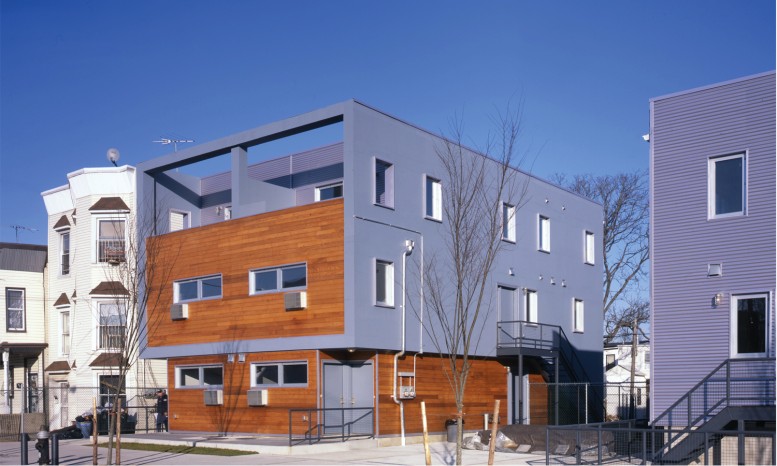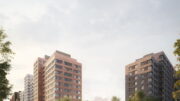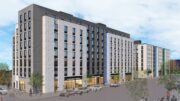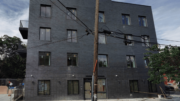Last year, the de Blasio administration rolled out a program to encourage developers to build one- to four-family homes on small city-owned lots, mostly in eastern Brooklyn. And just as the city is pushing through a contentious rezoning in East New York, it has filed plans to develop townhouses on 16 vacant properties in East New York, Ocean Hill and Brownsville.
The Department of Housing Preservation and Development (HPD) told YIMBY that the city is resurrecting the New Foundations program, a Bloomberg-era policy reborn under the current mayor as the New Infill Homeownership Opportunities Program (NIHOP). Spokeswoman Libby Rohlfing wrote in an email, “We currently are looking at these sites to determine whether they can still meet the goals of our old New Foundations program, an affordable, mixed-income homeownership program, through one of our current programs.”
Both programs require builders to set aside a third of their units as affordable housing. The below-market units must be affordable to households making up to 80 percent of the Area Median Income, or $69,050 for a family of four, according to HPD’s website.
In exchange, the city transfers the property to the developer for a dollar. Under New Foundations, developers had to pay the city $1,000 in cash for each planned apartment, but it’s unclear whether that still applies.
The remaining units can be market rate. Alternatively, they can go to households earning between 80 and 100 percent AMI (a max of $86,300 for four people), or between 100 and 130 percent AMI ($112,190 for a family of four). If the homes include rental units, those apartments can rent to people making up to 165% AMI, or $142,395 for a four-person household.
In general, HPD and the developer sell the homes through a lottery, and buyers’ incomes are capped at the high end of the affordable spectrum—130 or 165 percent AMI.
Not surprisingly, all these income levels are much higher than what working class families in eastern Brooklyn can typically afford. Ocean Hill and Brownsville’s community district has a median household income of just $27,166. Families next door in Community District 5, which covers Cypress Hills and East New York, have a median income of $36,829.
The city will offer up to $70,000 worth of subsidies for each apartment in a new building. Most of the homes filed in the past two weeks are three-family buildings, meaning that they city would give each project as much as $210,000.
Essentially, the city is offering developers subsidies to build market-rate housing on less-than-desirable lots. Affordable housing developers prefer to build at least 20 units, because it’s difficult to finance anything smaller. But the vacant lots we’re talking about are 20 or 25 feet wide—just big enough for a pre-war row house, with five or six apartments at most.
The New Foundations program hasn’t been active since the recession, but back in 2009, three-family homes built under the program in Ocean Hill were asking between $576,500 and $696,500. Another New Foundations development in East New York, Glenmore Gardens, offered two-family homes for $329,000 when it opened in 2007. Although the city rarely sponsors new construction, affordable condo developments, Glenmore Gardens included some condos geared toward middle income families.
New building applications reveal that the houses will range from 2,800 to 4,500 square feet and rise three or four stories. While most will have three or four units, two projects located in the New Lots section of East New York will have two apartments each. HPD hasn’t explained how a two-family home would be divided into thirds to accommodate affordable units.
And it’s worth noting that all of these lots fall outside of the blocks set to be rezoned in East New York and Ocean Hill. So they wouldn’t be subject to the administration’s new mandatory inclusionary housing (MIH) policy, which requires that a quarter of all units built remain permanently affordable.
Hackensack, N.J.-based architect Jose Carballo applied for the permits, and HPD is listed as the developer.
And this isn’t the first time the city has tried to develop these empty plots. Dabar Development Partners, a small firm that’s worked on a few projects in Harlem, was originally going to develop 22 townhouses on these properties in Ocean Hill and East New York. But HPD pulled funding for the project when the market took a dive in 2009. Back then, Dabar founder Dawanna Williams told The Real Deal that the development would cost $9 million, to which the city would contribute 15 percent. Williams wasn’t able to find additional financing, and her townhouses never materialized.
While YIMBY supports small development in these neighborhoods, this seems like an unpopular time for the city to build housing that most residents in the area can’t afford. City Planning’s proposal for East New York promises that the rezoning will produce 6,300 new units in the next 15 years. Half of those will be affordable to local residents, and a quarter of all the new units will be permanently affordable, thanks to inclusionary zoning. That’s a huge sticking point for activists, neighbors, and some local politicians, who demand more below-market units.
After DCP officials presented the East New York rezoning plan to the local community board last month, state Assemblymember Charles Barron offered harsh criticism. “They’re going to tell you, we need a diversity of income,” he said. “Without a diversity of income, we’re not going to be able to build our economy. That translates to, we need to have white folks in here. If you want transit stuff, you need white folks in here. If you want a new school, you need white folks in here.”
Coincidentally, one of the new townhouses is planned across the street from Barron’s district office, on an empty lot at 668 Vermont Street in the New Lots area of East New York.
Subscribe to YIMBY’s daily e-mail
Follow YIMBYgram for real-time photo updates
Like YIMBY on Facebook
Follow YIMBY’s Twitter for the latest in YIMBYnews






Even with the free land in crummy ENY labor costs prevent ‘cheap’ homes from being built. I don’t think comrade Charles Barron has to worry about ‘white folks’ moving into his slum district. Funny but way back when the Italian and Jewish ‘white folks’ lived in ENY it was a safe working class neighborhood.
ENY was never a safe neighborhood; that’s racist revisionism. It was the home of the predominantly Jewish ‘Murder Inc’ which was responsible for between 400 and 1000 murders, and it was also a hotbed of Italian Mafia activity.
https://en.wikipedia.org/wiki/Murder,_Inc.
The old Jewish and Italian gangsters were a bad group but only killed each other. They didn’t rob grandmothers on the street or kill store-owners in robberies.
What a load of baloney. People say the same thing about the modern thugs–it’s alright as long as they kill one another. Guess what? It’s not that simple now, and it wasn’t that simple then. The mobsters would extort money from store-owners for ‘protection’ back in the day– basically another form of robbery. If the owner didn’t pay up, he could expect to be assaulted or worse. Bystanders would get killed in drive-by shootings. And the murder rate overall was higher then in ENY than it is now. Take Jewish mobster “Pittsburgh Phil” Strauss, for instance–he was picked up by cops over 18 times for robbery, assaults, and drug dealing. I doubt all of his victims were mobsters:
https://en.wikipedia.org/wiki/Harry_Strauss
But these facts don’t matter to you, because you’ve already made your mind up and you’ve got something to “prove” about Italians and Jews being better than blacks.
Another one of the old Murder Inc guys was Abe “Kid Twist” Reles. He definitely killed people who weren’t mobsters:
“Reles became known as a particularly cold-blooded and psychopathic murderer. On one occasion, in broad daylight, he attacked a worker at a car wash for failing to clean a smudge from the fender of his car. Another time, Reles killed a parking lot attendant for failing to fetch his car fast enough. On another occasion, he brought a guest to his mother-in-law’s home for supper. When his mother-in-law retired after the meal, Reles and another gang member murdered the guest and then removed the body.
…
Reles lived at 649 East 91st Street in Brooklyn, before moving to 9102 Avenue A, also in Brooklyn.”
I’m still trying to figure out how a family of 4 can make 69k a year. When I think of a family of 4, especially in that neighborhood its a mom and her 3 kids, or maybe parents and their 2 children.
Find me a home where 3 or 4 adults are working.
I work two jobs totaling about 70,000 a year. My mother and father are disabled and cannot work. My younger sister is in college. Believe it or not, it happens.
ex brooklyn guy – I agree that Charles Barron is an idiot – but Brownsville was always dangerous – even when it was Jewish and Italian. East NY also spawned many gangsters – including the ones who used to rule in Ozone Park, Queens. Let’s not re-write history.
Brownsville was working class Jewish, ENY was working class Italian, Irish, Jewish. They were not high crime areas until minorities took over in the mid 1960s.
Sorry but you are wrong… next you will tell us East Harlem was just working class Italians and Hell’s Kitchen was working class Irish and there was no crime in those areas. Same with Red Hook and Gowanus and the Lower East Side right? No crime then huh? I’m sure you’d say the same thing going back to the Tenderloin and 5 points eras. Revisionist history.
I am surprised that YIMBY is quoting Barron’s ugly race-baiting remarks at the CB 5 community meeting. Those were just a few sentences from an ugly tirade. I do think that people with higher incomes will start to move out to Cypress Hills and East New York as prices in neighborhoods such as Bed Stuy, Bushwick, and Ridgewood climb out of reach, but Barron’s hostile and hateful attitude will not solve the problem of displacement.
Crime aside, ENY is too far east on the subways. It’s a long ride through rough areas from there into Manhattan.
We do not condone Barron’s race-baiting, but that doesn’t mean his remarks should remain unpublished. Reporting & endorsing are two different things! 🙂
Cypress Hills and parts of ENY near the subway do not have a long commute at all. The express Z train runs all through the area and it takes me 35 min to get to lower manhattan. I had a longer commute to get to high school on the subway when I was a kid.
I wish the purpose of all of these changes were for the citizens who have lived here for the past 20-40 years. Instead, the gov is just accommodating for the rich guppies who move to nyc from wisconsin but cant afford manhattan. im sick of it. nothing wrong with diverse neighborhoods, but there’s a problem when things are only being upgraded bc of these people moving in. moving the poorer folks out does nothing but push them and the criminals to another area. why do you think chicago is so bad? upgrade the community and nyc as a whole by producing more jobs for the youngsters so they dont resort to crime. poverty=crime. you’d think ppl would get it by now but its seems to not be the case…
Nothing but more land grabing for the wealthy on the cheap. NYC tax payers are picking up the check while developers picks up the tip for a meal that leaves the tax payer unsatisfied. Many of those low income earners pays local taxes as well but are not benefiting from the city’s tax abatement development deals. All these housing developments that are to allocate a portion of units for low income residents are not doing it. These high rise luxury buildings that have gone up under the city’s deal do not reflect the diversity of low income NYC residents. Stand outside one of these so called low income allocated buildings and observed for your self how little diverse the tenants are. A city as racially diverse as NYC this is more then a coincidence. If the Feds would conduct an investigation they will most likely discover a lot of corruption, along with a whole lot of civil Rights violations and NYC’s politicians and agencies will be in the middle of it. First of all , the application for residency in these buildings are kept out of public view. The city should be posting the application into these city assisted developments in news papers , libraries , their Website , even to make radio and TV announcements. Instead they keep the info as unpublicized as possible. Things that are done in secrecy usually breeds corruption. Instead of Mr.Barron’s ranting why don’t he call for an audit on how diverse these low income units are being allocated. I’m pretty sure that will not make someone’s day.
I don’t see the issue. If the housing for locals is eliminated, they have to move away and are no longer a local problem.